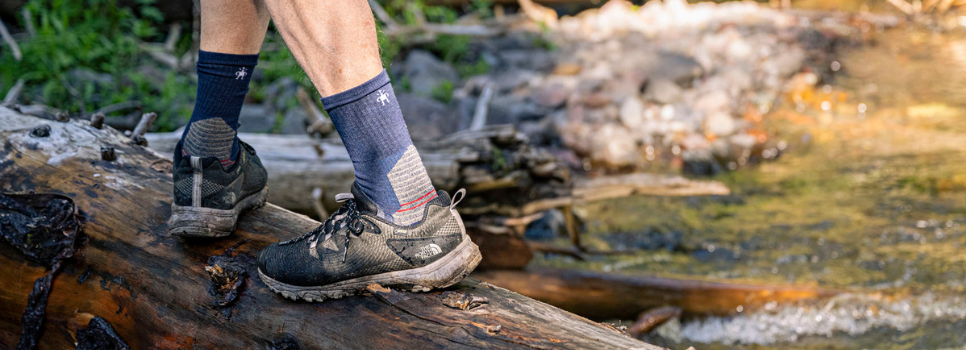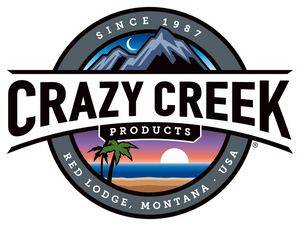- Z

Everybody knows how vital good footwear is yet we often only consider the boot or shoe when deciding what to purchase. It doesn’t matter how good your boots are, if your socks are uncomfortable or poor quality you may as well be wearing possum skins. When the condition of your feet is so closely tied to your overall comfort, it only makes sense to spend the extra time and dollars on a pair of good quality socks. But what constitutes a good pair of socks?
We feel that a good sock possesses a few essential qualities:
- Most importantly, they should be comfortable.
- They should be durable.
- They should keep moisture away from the skin.
Socks must be chosen carefully to match the activities you have planned and the weather conditions you expect on your trip. Often you may find that it pays to carry a couple of different types of socks to better cover your needs.
Types of Socks
Liners
Sock liners are thin, light, moisture-wicking socks designed to be worn right next to your skin. Liners help reduce the likelihood of blisters by wicking sweat away from your foot to keep you dry and to reduce the abrasion between an outer sock and your skin. Liner socks are designed to be worn under other socks. They are available in both warm and cold weather versions.
Running or Racing socks
Racing socks are technical lightweight socks designed for short and long-distance running and adventure racing. These lightweight, technical socks offer protection and support in key wear areas. While their breathable moisture-wicking material keeps your feet dry during the race.
Lightweight walking socks
These technical socks are designed for warm conditions while wearing lightweight shoes or boots. Lightweight walking socks are designed to wick moisture and breath effectively, making them best-suited for warmer climates. These socks are thicker, warmer and more durable than racing socks and will provide more cushioning with extra ankle height for wearing with boots.
Hiking socks
Thicker and warmer than the lightweight option, Hiking socks provide reliable cushioning and insulation in moderate to cold conditions. Better suited when wearing heavyweight boots, many models have extra padding built into high-impact areas like the heel and the ball of the foot for maximum comfort. These socks can also be worn with liners to improve wicking, comfort and warmth.
Mountaineering socks
Mountaineering socks are generally the thickest, warmest and most cushioned socks available. Mountaineering socks offer technical construction for support in all the right areas for when you are wearing heavy stiff boots. They are designed for long trips and tough terrain in cold temperatures.
Ski socks
Designed specifically for wearing with skis. Ski socks are long, thick and warm with plenty of support in all the appropriate areas and offer extra calf support to help them stay up.


What are the different types of Sock Materials?
One of the most confusing aspects when choosing a pair of socks, is understanding what the different materials actually are and their functional benefits. Most socks will combine a number of different materials and construction techniques, to optimise performance.
Natural Fibers
Natural fibres make use of the inbuilt properties of these materials. They are also considered to be more environmentally friendly relative to synthetic materials. However no two natural fibres are alike and it is important to choose the right material for your trip.
Cotton
Cotton is not recommended as a sock material for travel or the outdoors. Cotton absorbs sweat, dries slowly and it provides no insulation when wet, this may lead to discomfort and blisters.
Bamboo
Bamboo socks are not recommended for hiking due to their incredible ability to retain water. Although they are breathable, if they become wet, from sweat, rain or puddles, bamboo socks can take a long time to dry.
Wool
Each wool fibre is made up of millions of "coiled springs," that stretch in use, but coil back to their original positions. It features inherent qualities such as warmth when wet, cushioning, shape recovery (resiliency) and it breathes with your body. It can be knit in various weights to provide different levels of insulation for every temperature. Wool yarn, when knit into a thicker sock, tends to be bulky which allows air to becomes trapped between the fibers for insulation. Wool socks also keep feet drier as wool absorbs as much as 30% of its own weight before it begins to feel damp. Unfortunately, wool can take a long time to dry and can be scratchy or uncomfortable next to your skin.
Merino Wool
Merino wool is the perfect material for socks. It maintains all the characteristics of classic wool but it is lighter and much more comfortable against the skin. Merino wool does not itch and is shrink-treated to hold its size and shape even after repeated washing. A great benefit of merino socks is their antimicrobial properties that resist odours. This means they can be comfortably worn for consecutive days on the trail for longer treks.
Synthetic Fibres
Synthetic materials are designed to insulate and wick moisture while providing a shorter drying time than wool. Synthetic materials are designed to trap warmth like wool. However the main benefit of synthetic socks relative to wool is their ability to manage moisture. Synthetic wicking materials like polypropylene and Coolmax are often woven into thicker walking socks to enhance wicking performance. They also dry more quickly which may help to prevent blisters. These fabrics are available in a variety of styles and thicknesses.
Acrylic
A highly durable synthetic fibre that provides softness and warmth with little weight.
Nylon & Stretch Nylon
A very strong, versatile, hard-wearing fibre. Socks made of nylon can have many different styles, such as thin and silky or bulky and highly elastic. Nylon is often used with other fibres to give added stretch or to improve durability.
Polyester & Stretch Polyester
Both polyester and stretch polyester are hydrophobic (water repelling) fibres, known for their durability.
Polypropylene
A fibre that won't accept moisture. Often appears alone or in conjunction with an absorbent outer layer. When combined with a second absorbent material together the fabrics work to wick moisture away from your body. The fibres are incredibly strong whilst being the lightest of any synthetic fibre.
Shop


Lifetime Club Membership
Join the Paddy Pallin Club for $10.00 and receive a 10% discount on all future purchases.*
Benefits
Exclusive Club Member sales, promotions, and events!
*Club Member discount not applicable to gift cards and services
such as repairs. Discount may not be used in conjuction with any offer






















































































































































